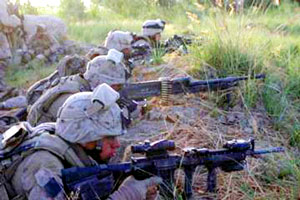JIM.LOBE

WASHINGTON (IPS/GIN) – Six and a half years since the ouster of the Taliban, U.S. media attention is returning to Afghanistan, where more U.S. and NATO troops were killed in June than in any previous month.
Indeed, as noted by both the New York Times and the Washington Post, June was the second month in a row in which U.S. deaths in Afghanistan approached the toll in Iraq, where the addition of some 30,000 troops last year and more aggressive counter-insurgency tactics have helped to reduce sectarian violence and attacks against U.S. and allied forces.
Twenty-eight U.S. troops were killed in Afghanistan in June, just one fewer than the 29 in Iraq, while another 18 soldiers from Washington’s allies also lost their lives to Taliban forces. The British military, which has the second-largest contingent in Afghanistan, lost 13 soldiers, including the first servicewoman killed in the war.
Even President George W. Bush admitted July 2 it had been a “tough month” in Afghanistan, insisting, however that the increase in the death toll showed that the coalition forces were taking the offensive.
“You know, one reason why there have been more deaths is because our troops are taking the fight to a tough enemy, an enemy who doesn’t like our presence there because they don’t like the idea of America denying safe haven,” President Bush told reporters in the White House Rose Garden.
And while most analysts agreed that the increase in the number of coalition deaths was indeed a result of U.S., British, Canadian, and Dutch forces, in particular, moving into areas in the eastern part of Afghanistan where their presence had previously been sporadic, they also credited a sharp rise in Taliban activity and its adoption of more unconventional tactics, including the use of explosive devices imported from the Iraq war.
“What it points to is that the opposition is becoming more effective,” Barnett Rubin, an Afghanistan expert at New York University, told the Post. “It is having a presence in more areas, being better organized, better financed, and having a sustainable strategy. In all, their strategic situation has improved.”
Indeed, the record for May and June has suggested that the Taliban is at least as much on the offensive as U.S.-led forces, which together have reached an all-time high of some 60,000 troops, of which about half are from U.S. allies operating under NATO command.
In addition to the growing death toll, the Taliban mounted a particularly bold assassination attempt against President Hamid Karzai during a military parade in Kabul in late April, and in mid-June staged a spectacular jailbreak in Kandahar that freed hundreds of suspected collaborators and subsequently seized and briefly held seven villages around Afghanistan’s second-largest city.
In late June, a new Pentagon report–the first review of the situation in Afghanistan since the U.S.-led invasion in late 2000–concluded that the Taliban has effectively “coalesced into a resilient insurgency” that was spreading into previous, relatively peaceful parts of the country.
The report also predicted that violence–already at unprecedented levels since the Taliban’s ouster–will likely increase through the rest of the year. Maj. Gen. Jeffrey Schloesser, the top U.S. commander in eastern Afghanistan, told reporters that attacks in his sector increased by 40 percent in the first five months this year compared to the same period in 2007.
While no one believes that the Taliban is powerful enough to oust the Karzai government or defeat–or even directly challenge–U.S. and NATO forces there, the Pentagon has been arguing for several months that it needs at least 10,000 more troops deployed to Afghanistan to adequately cope with resurgent insurgency.
But where those troops will come from remains a major question. In late March, French President Nicolas Sarkozy said he would send 1,000 more troops to Afghanistan. Germany last has announced that it would send some 1,000 troops later this fall to bring its total force there to some 4,500, but the conditions attached by Berlin to their deployment forbid their involvement in combat.
The Pentagon, which added 3,000 marines to its Afghan force earlier this year, has been unable to come up with more of its own troops because of Mr. Bush’s insistence that nothing be done to put at risk the relative stability that his “surge” strategy in Iraq has helped achieve. As a result, the current drawdown from Iraq from 170,000 troops earlier this year to some 140,000 troops by August will be suspended at the end of July.
Defense Secretary Robert Gates and the Pentagon brass had hoped withdrawals would continue at roughly 5,000 troops a month beyond July, thus freeing up many more troops for deployment to Afghanistan. But those hopes have now been put on hold indefinitely to the clear frustration of Sec. Gates and the chairman of the Joint Chiefs of Staff, Adm. Mike Mullen.
Public support for more troops in countries that are expected to supply them is also growing increasingly doubtful. Indeed, a recent multi-national Pew Global Attitudes Project poll conducted in April–that is, before the bloody months of May and June–found bare pluralities of respondents in the U.S. and Britain in favor of “keep(ing) troops in Afghanistan until the situation is stabilized” as opposed to removing them.
In NATO members France, Germany, Spain, Poland, and Turkey, on the other hand, majorities ranging from 54 percent to 72 percent said they believed the U.S. and NATO should withdraw. Only in Australia, a non-NATO country that has contributed combat troops to both Afghanistan and Iraq, did a strong majority (60 percent) say they preferred to stay.
Related links:
Is oil the motive for war? (FCN/Minister Louis Farrakhan, 02-17-2002)
FCN Interview with former Taliban Ambassador A. Mujahid (01-09-2001)












